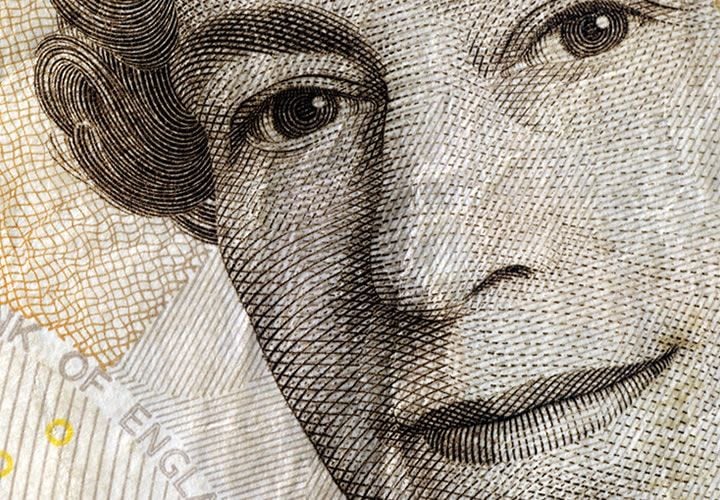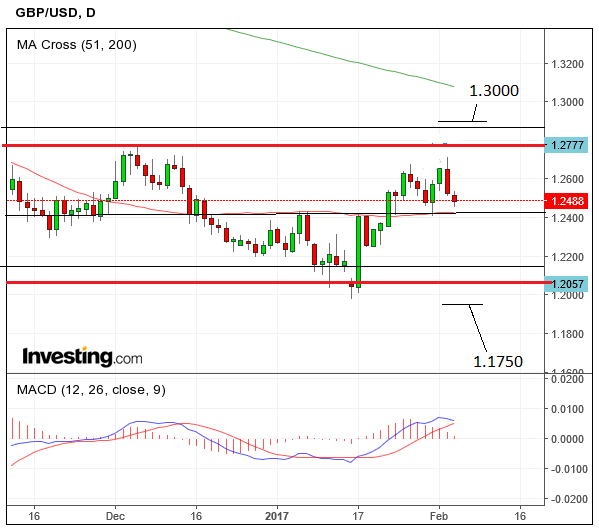GBP/USD X-Rate 5-Day Forecast: 1.24 is Key

The British Pound continues to wrestle the US Dollar within a familiar range with GBP/USD carving out territory between 1.20 towards the bottom and 1.2775 towards the top.
This suggests to us that markets are happy to value the UK currency within this broad range based on what they at the present time concerning the Brexit process and Donald Trump's economic policies.
While a sideways-orientated trend is occuring on a multi-week timeframe, near-term pressures are biased against the UK currency which and GBP/USD is likely to test the middle of the range, and potentially lower, over coming days.
Our technical studies have concluded that the exchange rate will likely continue moving within this range until a clear breakout occurs in one direction or another.
For a break higher to be confirmed, we would want to see a move above the 1.2900 resistance level.
This would be expected to move to an initial target at 1.3000, followed eventually by a move up to the 200-day moving average at 1.3100 where we would expect strength to be tested once more.
Moving averages are dynamic areas of support and resistance so resistance from the 200-day is likely to act as a barrier against further appreciation.
Analyst Thoams Light, Head of Research at Faraday Research, is watching the 1.24 level saying it will be key to the GBP/USD's direction this week:
"The 1.2400 marker remains a key area of short-term support. How prices respond to this level will likely set the tone for the week.
"We’ll be keeping an eye out for lower timeframe bullish reversal patterns within the support zone whilst keeping in mind that a break and close below 1.2400 could trigger a much sharper sell-off."
The Political Dollar Needs Clarity from Trump
The outlook for the Dollar remains largely tied to the economic agenda of Donald Trump - this is a political currency.
The prospect of longer-than-foreseen delays in the implementation of Trump’s tax reform agenda has dampened inflation expectations and pushed down US Treasury bond yields.
Lower inflation expectations translate into lower interest rate expectations which means a weaker Doller.
“The likely delay in tax reform is skewing risks to lower rates in the near term. We believe that until we see some signs of a consensus on tax reform, the 10y should trade between 2.25-2.5%,” said TD Securities in a note seen by PSL.
A surprising difference of opinion about Trump’s radical changes to the tax code at a recent meeting of congressional Republicans in Philadelphia seems to be at the root of the delay.
“The most troubling revelations was the following: "When it comes to tax reform, senior congressional aides said the spring of 2018 might be a more likely time than this year for the passage of legislation.",” commented Zerohedge’s Tyler Durden.
The Big Question for the Dollar: Two or Three Hikes?
In the week ahead, analysts will get the opportunity to refine their view of how many times the Federal Reserve are likely to raise interest rates in 2017.
The lower-than-forecast average earnings data from Non-Farm Payrolls suggested the possibility of a slow down in Fed rate-hiking which in turn could hold the Dollar back.
Analysts at TD Securities see the Fed making three hikes while others analysts notably at Nordea Bank and Lloyds Bank Commercial Banking now think two rather than three hikes is more likely given the slowdown in wages.
Societe Generale expect the Fed to slowdown hiking rates as a result of the lacklustre growth in earnings, “the impression is of an economy generating solid jobs growth without putting any additional pressure on wages, which will allow the FOMC to be very slow in raising rates.”
Fed speakers may come front and centre for the market in the week ahead due to the dearth of other information.
“Markets will look to Fed speakers for their assessment of economic conditions and more clarity following the Feb FOMC. Harker, who has a hawkish lean, speaks on Monday and his Q&A should serve as a highlight given his new status as an FOMC voter (for the first time). We will also get comments from Bullard (NV) and Evans (V) on Thurs, which also have some potential to move markets,” say TD Securities.
Uncertainty and Current Account Gap to Weigh on Sterling
The Pound failed to react positively to the Bank of England’s (BOE) upwards revision to growth forecasts.
The Pound’s decline was explained as resulting more from a surprising lack of downside after the referendum rather than an “improvement in the scenario”, according to Intesa San Paolo’s chief economist Luca Mezzomo
Continuing upside risks to inflation due to the weak Pound rather than increased demand, as well as uncertainty about the triggering of article 50, have kept - and are likely to keep the Pound subdued.
“We confirm our expectations for a possible – albeit modest – weakening of the pound in the near term, mostly due to the new phase of uncertainty that will begin once the Brexit process is officially triggered,” said Intesa’s Mezzomo, who expects GBP/USD to fall to 1.20 at the bottom of its range.
On a broader macro front SocGen’s Juckes notes headwinds from the massive Current Account deficit:
“Sterling is stuck in a range. It's very cheap on most measures, but then real yields are very low and the current account deficit is very big.”
Politics to Continue Driving Pound
The big event in the week ahead will be the debate in Parliament over the Brexit Bill and subsequent vote in the Commons on Wednesday, February 8.
Important amendments to the Bill will be discussed during these debates in relation to how ‘Hard’ or ‘Soft’ Brexit should be.
The proposed amendments include:
- the request that before activating the withdrawal clause, Parliament may pre-emptively discuss whether or not the United Kingdom should exit the single market;
- the request that Parliament be regularly updated by the government on the advancement of the negotiations;
- the request that, once the final agreement has been reached on new relations with the EU, Parliament, that will have the power to vote to approve the agreement, may ask to extend negotiations in order to reach a better agreement;
- that the rights of EU citizens living in United Kingdom be guaranteed, or at least defined; that the government publish an assessment of the impact of Brexit on specific sectors, such as climate change, social inequality, and public finance
Once the vote in the Commons is passed the House of Lords will have their turn to debate and vote on the Bill on February 20.
It is then expected to be finally invoked on March 7.
From a data perspective, the big release will be Manufacturing and Industrial Production on Friday, February 10, at 9.30.
Analysts estimate a downtick to 0.4% from 1.3% previously for Manufacturing, and Industrial Production slowing to 0.2% from 2.1% in December.
The Trade Balance, also released on Friday is expected to show a narrowing of the Deficit to -11.4bn from 12.16bn in December.












